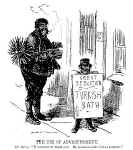4. Attitudinal issues: cleanliness

The technical problems arising from the introduction of the bath were all solved sooner or later, more or less gradually, as usually happens in any developing technology.
Whereas the more numerous attitudinal controversies—such as determining what are the optimal temperatures and acceptable degrees of humidity, or doctors’ reactions to the Turkish bath as a perceived threat—often led to furious disputes, some of which continued into the twentieth century.

It is just possible that had the Turkish bath been introduced solely as an improvement on the vapour bath as a cleansing agent, it would have met with little opposition. Though even here we cannot be certain. Urquhart reportedly upset the local population when he told the inhabitants of Cork that they needed Turkish baths because they were a dirty people.10 As Dr Samuel Jeaffreson, himself actually in favour of the bath, told the BMA some years later,11 in response to similar arguments from other advocates:
It is somewhat repugnant to the English notion to be told that we are a dirty set of fellows; that our baths, our sponges, our soap, and flannels, only increase our filth by rubbing the dirt in; and that cleanliness can only be obtained, not ‘by the sweat of our brows’ only, but that we must be washed from within outwards by myriads of rippling streams of perspiration.
The fact of the matter is that the overwhelming majority of the population were at that time unaccustomed to regular bathing and the Turkish bath introduced a whole range of new and, sometimes, even terrifying experiences. In 1860, for example, the manager of the Rochdale Co-operative Turkish bath wrote a short pamphlet12 for prospective bathers in which he said,
Many are afraid of the Turkish Bath, simply because of the cold shower after being in the hot room. We cannot blame such, because a short time ago we should have thought of nothing but instant death if such a change had been proposed to us.

Cold shower
at Cragside
He explains how to take a shower:
The proper plan, and one which makes the matter quite easy, is to stand firmly with the feet exactly under the centre of the rose. Make an effort to brace up the nerves, and assume a defiant attitude as though about to encounter an enemy. Let the first shock of cold fall on the face and chest, then move the upper part of the body gently to and fro, so that the water may fall on the back and front alternately; then on the sides in turns, holding up the arms alternately, that the armpits and sides may receive their due share of the bracing stream.
And after dealing with other parts of the body, he continues:
When there is time and opportunity, the pleasure may be increased by the bather putting his hands on the floor, and moving about, or laying down, so as to receive the shower on different parts of the body. By laying on the back the feet may be held up, which is very agreeable. In short, the shower should be a source of fun to all who take the Turkish Bath…
 Today this amuses us, but in the middle of the 19th century, no less a person than George Jacob Holyoake wrote that Mr Jagger’s pamphlet was ‘a very sensible and practical tract’.13
Today this amuses us, but in the middle of the 19th century, no less a person than George Jacob Holyoake wrote that Mr Jagger’s pamphlet was ‘a very sensible and practical tract’.13

